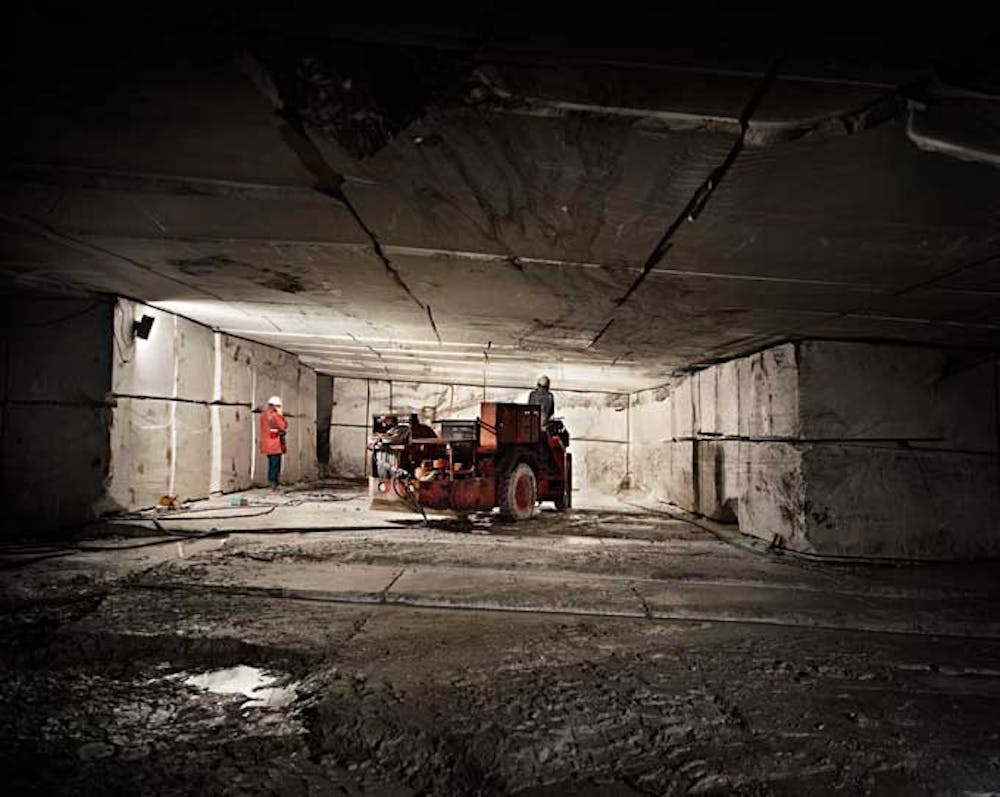Nature Transformed, which is on display in the Museum of Art through April 21, presents a selection of Edward Burtynsky’s photographs of the Vermont quarry industry in the 90s. Burtynsky, a Canadian 2005 TED prize-winner, is a photographer who has achieved international recognition for his large-format photographs of the industrial landscape.
“Being almost the most visible environmental photographer in our time, Burtynsky’s project of quarr[ies] in Vermont turned out to be important and formative in his career,” said Professor of History of Art and Architecture Pieter Broucke, co-planner of this exhibit.
After conducting the bank architecture project and noting that the stones “had to have been taken out of the quarry one block at a time,” Burtynsky recorded in his artist statement that, “I envisioned an inverted cubed architecture on the side of a hill.” This inverted skyscraper concept led Burtynsky to Vermont. Once here, Burtynsky started his renowned exploration of nature and industry, working with and photographing the quarry stoneworkers. These stoneworkers, who immigrated to Vermont from Europe, introduced to Burtynsky the ancient quarrying town of Carrara, Italy; it was there that he finished his first overseas project.
Burtynsky first came to Vermont from Toronto in 1991. After that, he visited quarries in Vermont five more times. The photographs of his first visit, such as Rock of Ages #26, Abandoned Section, E.L., show the formal quality of quarries.
“Burtynsky was more interested in the surface of the quarry during his first visit,” Broucke said. “... there is just a little bit of sky and Vermont landscape on the top of the photograph. The pattern of Smith Quarry in this photograph almost looks like a quilt.”
The development of the past century of quarry industry in Vermont is clearly shown in this photograph. Like an inverted skyscraper, blocks at this abandoned quarry site get larger and larger from top to bottom with the changes of technology from vertical parallel drilling to cable cutting marked on them.
As a teaching museum, the Museum of Art, collaborating with Hood Museum of Dartmouth College, aims to convey the stories behind the photographs through Nature Transformed. In a catalog called Nature Transformed: Edward Burtynsky’s Vermont Quarry Photographs in Context, specialists in a variety of disciplines from both colleges interpret these photographs through a variety of lenses, including the history of photography, social history of the migration of stone workers from Italy to Vermont and the geology of the quarry in Vermont. These interpretations provide a backdrop against which to view the photographs and give visitors a better understanding of the scholarly context of the exhibition.
The introduction section of Nature Transformed includes the geological map of New Hampshire and Vermont, a photograph of Burtynsky, a Middlebury owned Rock of Ages #19 and title wall. There are two main sections — marble quarry photographs and granite quarry photographs — marked by a marble bench and a granite bench in the hall. Abandoned Marble Quarry #18, OMYA #51 and Vermont Marble Company #52, are arranged on the same wall, forming a lyrical and harmonious atmosphere. A series of photographs of the Carrara Marble Quarry follows Danby Marble Quarry #2, Underground Quarry to show how ancient quarries have formed the landscape of Carrara, Italy differently from Vermont.
The other side of the exhibition features photographs of a granite quarry from the other side of the Green Mountain. Rock of Ages #12, Rock of Ages #4 and Rock of Ages #25 depict the abandoned section of Adam-Pirie Quarry and are arranged in such a way that the water at the bottom part of these photographs seems to link and flow. The color of the water, turned green by the growing algae, and consuming the granite in the quarry, gives the photos an eerie glow. Within the granite quarry section, the Museum also compiled a display shelf of historical photographs of stone workers in Vermont from a century ago that tell the story of how the quarry came into being.
Measuring as much as 60-meters down into the Earth, quarry sites are considered to be scars on the landscape. In Burtynsky’s work, however, these scars become compelling and beautiful rather than visually disturbing.
“A variety of sites were chosen to present this sublime-scale modern industrial extraction activity, approximating their natural state,” Professor of History of Art and Architecture Kirsten Hoving explained in her March 5 lecture, “Digging Deep: Edward Burtynsky’s Vermont Quarry Photographs.”
“These abstracted objects convey implicit subtext of technology and consumption, which make these amazing visual images more than just pictures,” said Hoving.
Hoving believes that Burtynsky highly aestheticizes Vermont quarries by looking up-down, providing a complex and even confusing view that eliminates the horizon and thus avoids easy grasp of his photographs. Burtynsky’s elevated viewpoint is similar to Robert Adams’s quest to uncover human presence in the landscape in an exhibition called “New Topographics: Photographs of a Man-Altered Landscape” in 1975. Humans inhabiting the landscape continues to be an on-going concern of Burtynsky, and his large scale photographs continue to serve as a metaphor for industrial consumption on nature.
Burtynsky is coming to the College to speak about his photographic career as well as his exhibition on March 14. In addition, a series of lectures focusing on different aspects including social history and photography relating to the exhibition will take place in March and April on campus.
Photo Exhibit Depicts Vermont Quarries

Comments



